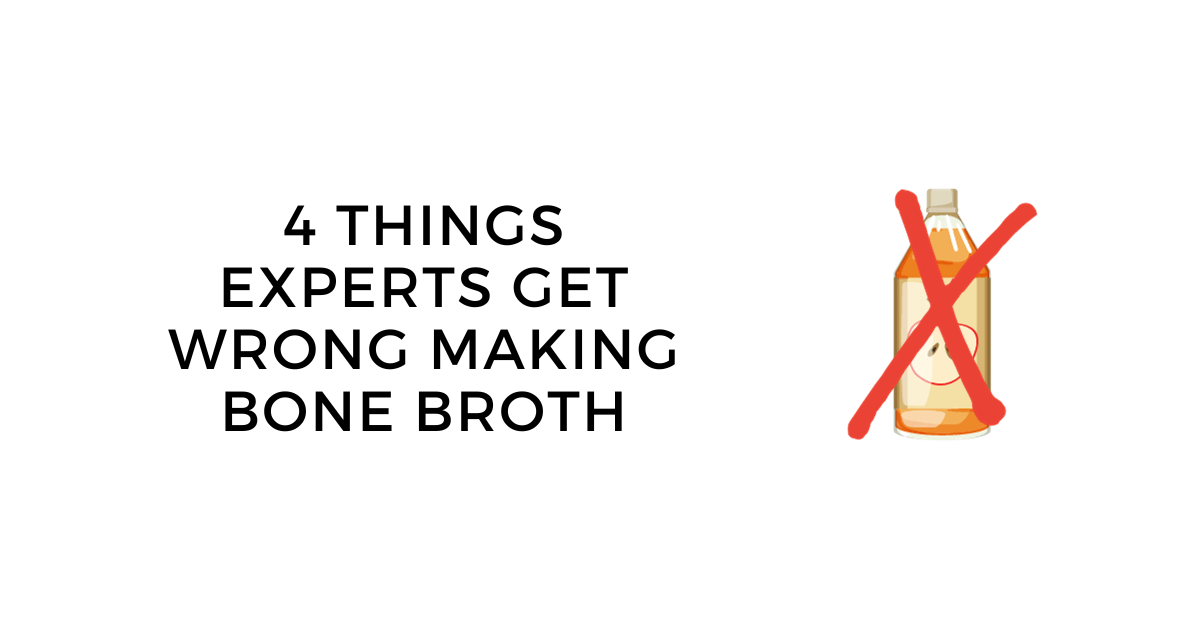
Apple Cider Vinegar in Bone Broth: And 4 Mistakes You're Making
Apple Cider Vinegar in Bone Broth
I get questions all the time on how to make a simple yet delicious bone broth. After years of making it daily, I’ve learned what works and what doesn’t.
The worst part is that all the recipes and info you read online is mostly wrong. Blogs and news sites tend to post the same misinformation on how to make crappy bone broth or bone broth vinegar.
I’m not sure where some of these mistakes started but I see most internet marketer food expert types peddle the same info on bone broth. It’s all wrong.
As a result I constantly get the same troubleshooting questions from friends and customers alike.

This article will go through the 4 things every supposed expert and website gets wrong about making bone broth. Ready? Let’s go!
Mistake #1: Adding Apple Cider Vinegar
Everyone and their mother thinks you should be adding apple cider vinegar or some type of acid to your bone broth.
Acid is typically added at the beginning with the water. Perhaps these armchair quarterbacks even recommend letting the bones sit with the acid in cold water for 30-60 minutes before turning on the heat.
Read the definitive list of bone broth brands you can trust.
The thought is that acid helps draw out nutrients from the bones even before you start simmering the bone broth.
What these charlatans and bloggers haven’t done is lab tested as much bone broth as I have. We send our bone broth for lab testing twice a year for vitamin and nutrient analysis, amino acid profiles and nutrition facts.
I suspect this is where some of the misconceptions around nutrient content in bone broth comes from. Similar uninformed bloggers peddle the notion that bone broth is rich in calcium. After all, it is made of bones, isn't it?
This is completely wrong. Look on the back of any bone broth and you’ll see at most 5% of your daily calcium per serving.
We’ve directly compared two batches of our bone broth for nutrients and vitamins. The first batch is made with apple cider vinegar, while the second without.

Guess what? There was no significant difference in vitamin and mineral content. A few percentage points here and there with respect to iron, calcium and vitamin C.
It is important to put things in context in terms of nutritional benefits to you. While 10 mg vs 12 mg is a 20% increase, it amounts to nothing in your daily intake of calcium.
Let me explain why. The recommended daily intake for calcium is 1000 mg.
10 mg serving represents 0.5% of your recommended daily intake.
12 mg serving represents 0.6%
If you want to save time and money in your homemade broth, I would argue it is a waste to use ACV to get an extra 0.1% of your daily intake.
But if you still prefer using it, then go for it.
Bone broth is not about the vitamins and minerals. It is about the gelatin, collagen, glucosamine and proteoglycans.
Next time you make bone broth, skip the apple cider vinegar. Your money is better spent elsewhere. If you do insist, you will end up with bone broth vinegar.
Read our secret recipe to making bone broth.
Mistake #2: All about the HEAT!

How hot should you cook your bone broth? Lots of websites encourage you to look for the perfect low simmer with the occasional bubble surfacing every couple seconds.
This is a recipe for weak broth with no gelatin and thus no nutritional benefit.
You should think of making bone broth as harvesting collagen and gelatin from bones and connective tissue. You need heat to harvest collage and gelatin in an efficient manner.
A low simmer will still work, but your cook time will be significantly longer. Perhaps two days at a lower temperature. Why wait when you can have it done quicker?
We recommend cooking your bone broth as hot as you are comfortable with without the broth spilling over your pot. If you have a thermometer, I’d recommend 98 degrees celsius.
This is a hard rolling simmer with lots of bubbles popping up. Don’t be afraid of letting it boil from time to time as well. Especially if you are home and able to watch over it every hour or so. If you go out or go to sleep, better to turn down slightly to 95 or 96 celsius.
With this temperature, you can make a collagen rich chicken bone broth in 10-12 hours and beef bone broth in 16-18 hours.
If you’re using a crock pot or slow cooker, then heat on high with the lid on. On the stove it is better to keep the lid off. Since you can achieve a higher temperature, the lid is not needed.
Moreover leaving the lid off lets the broth reduce naturally which results in more gelatinous and concentrated bone broth. If you notice it reduces too much, you can always add more water to the level you started with.
If you just want to try one and not obsess over making the best one, then read my guide on where to buy bone broth.
Mistake #3: Bones to Water Ratio
It takes a lot of bones to get that nice gel in your bone broth. This is where the big misconception around high prices for bone broth comes in.
Bones are expensive, and you need more than you’d think to make bone broth. This translates into why bone broth is not inexpensive these days, though we are working to change that.
So how many bones do you need for properly gelly bone broth? Think of your pot filled with bones as a cup filled with ice. You add water to the ice which fills in the nooks and crannies. The ice is the bones you’re using in this case.
For chicken bone broth we recommend 1.4:2 ratio of bones to water. If you have access the chicken feet to mix in with your chicken bones, then the ratio is closer to 1:2 bones to water (ex: 1 KG of bones per 2L of water).
For beef (or other ruminants) bone broth the ratio is closer to 1:2 bones to water, although this greatly depends on the type of beef bones you’re using.
Your mileage will vary depending on the bones you use, so best to experiment with a smaller batch before testing a larger one. There is nothing worse than finishing a lengthy simmer only to find you have average bone broth for your efforts.
Mistake #4: Poor Skimming Practises
Yes I’m calling you out for poor skimming practices. The first 1-2 hours of cooking bone broth is crucial as it sets the stage for the whole batch.
If you neglect skimming the fat, foam and impurities as they rise, you may end up with cloudy broth. There is nothing wrong with cloudy broth. In fact, this is how certain culinary cultures (Korea and Japan) prefer to make protein rich broths
This happens to the best of us. In our early days we had to pour out full batches of bone broth once or twice due to cloudy and murky broth. You know it when you see it. It looks like milk.
This is mainly due to not skimming properly, but also from stirring bone broth during the cook. Do not stir it, ever.
Take pride in skimming all the foamy bits every 20 minutes or so for the first 1 hour or however it takes to boil the broth for ten minutes or so. It is quite relaxing. After that you are good to go!
“Homemade broth, of course, is a whole food product. It’s a slow food, whole food, and real food that has been nourishing and healing people for tens of thousands of years.”
― Sally Fallon Morell, Nourishing Broth: An Old-Fashioned Remedy for the Modern World
Bottom Line
There you have it, 4 mistakes many people make when getting started making bone broth.
If you are considering purchasing bone broth then make sure that you find a quality product. The best one in my mind is the chicken bone both powder from Bluebird Provisions.
You can find it on Amazon prime for free shipping.
Have you made bone broth? Leave a comment and let me know how it went!
Sources:
(1) https://pubmed.ncbi.nlm.nih.gov/2592713/
(2) http://www.ncbi.nlm.nih.gov/pmc/articles/PMC1975347/
(3) http://jn.nutrition.org/content/7/5/535.full.pdf
(4) http://www.ncbi.nlm.nih.gov/pubmed/8082052
(5) https://www.ncbi.nlm.nih.gov/pmc/articles/PMC5533136

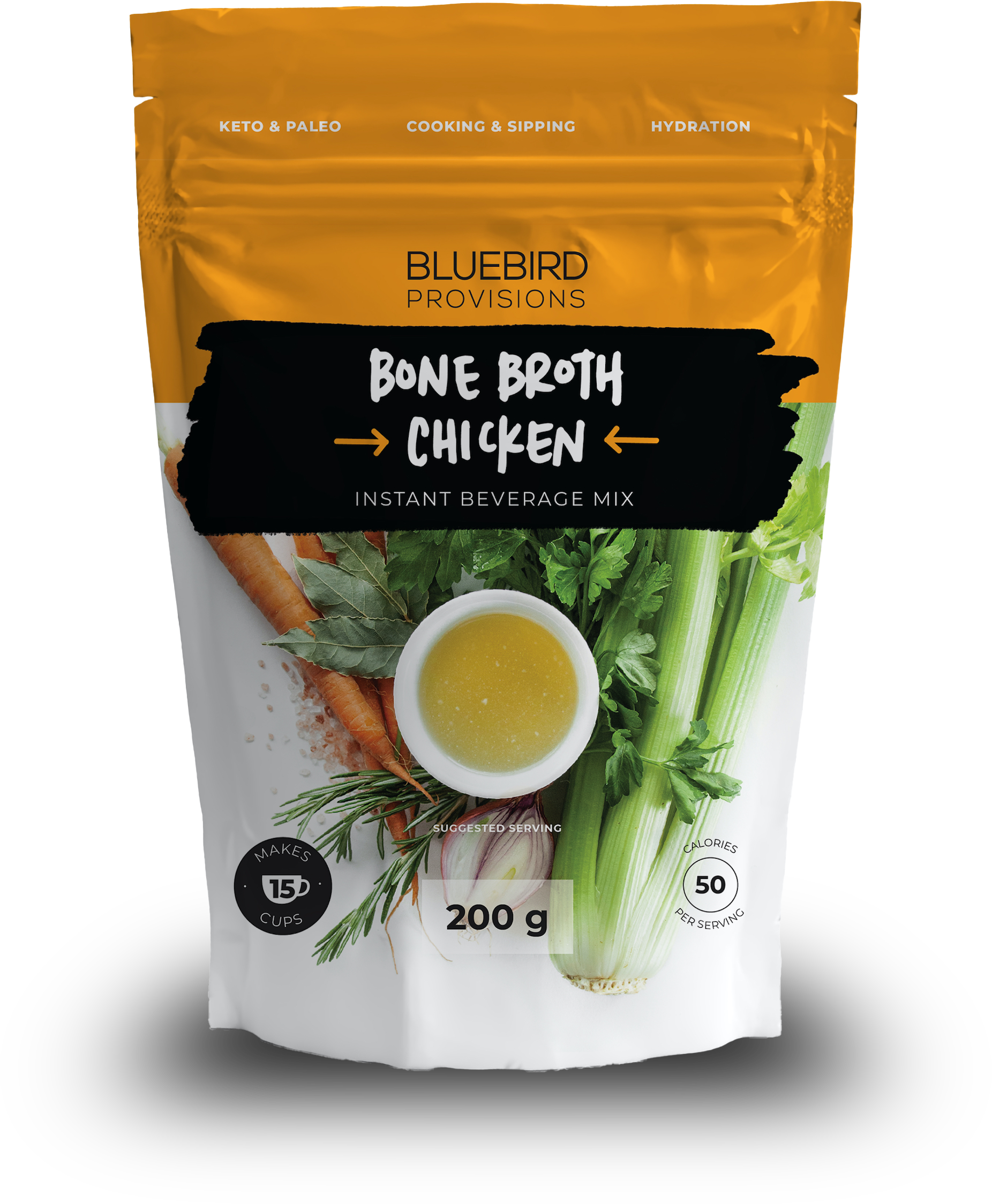

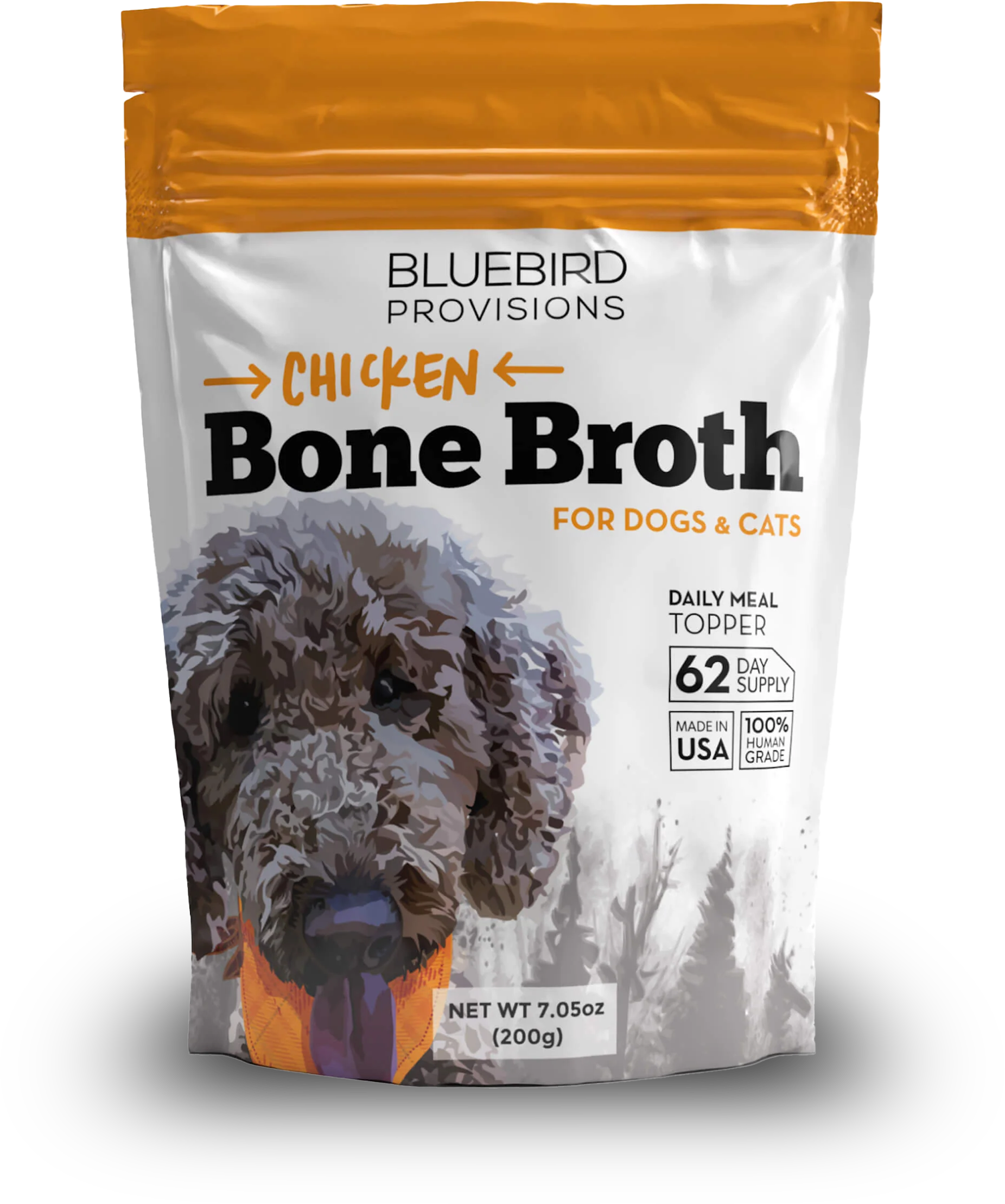
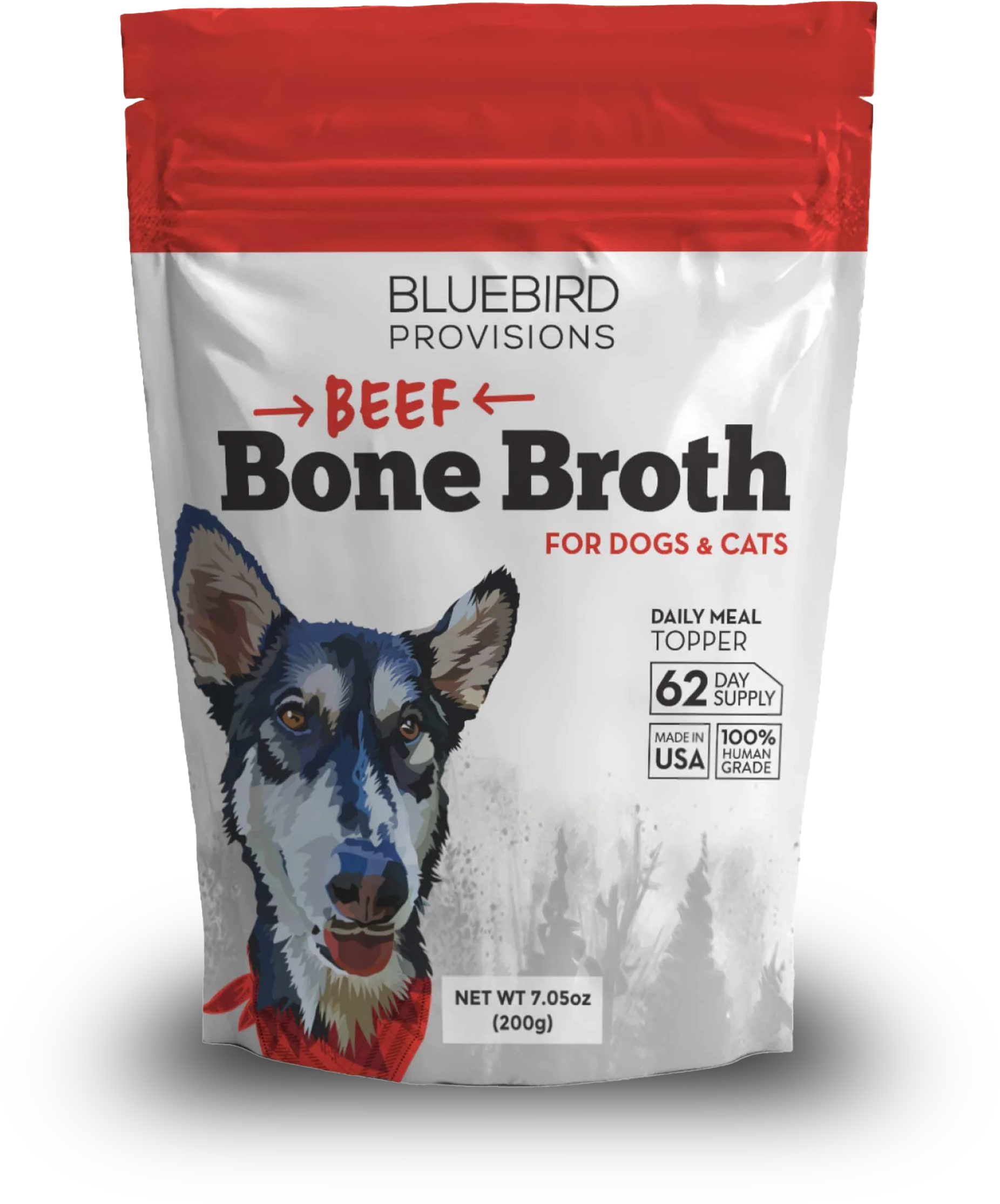

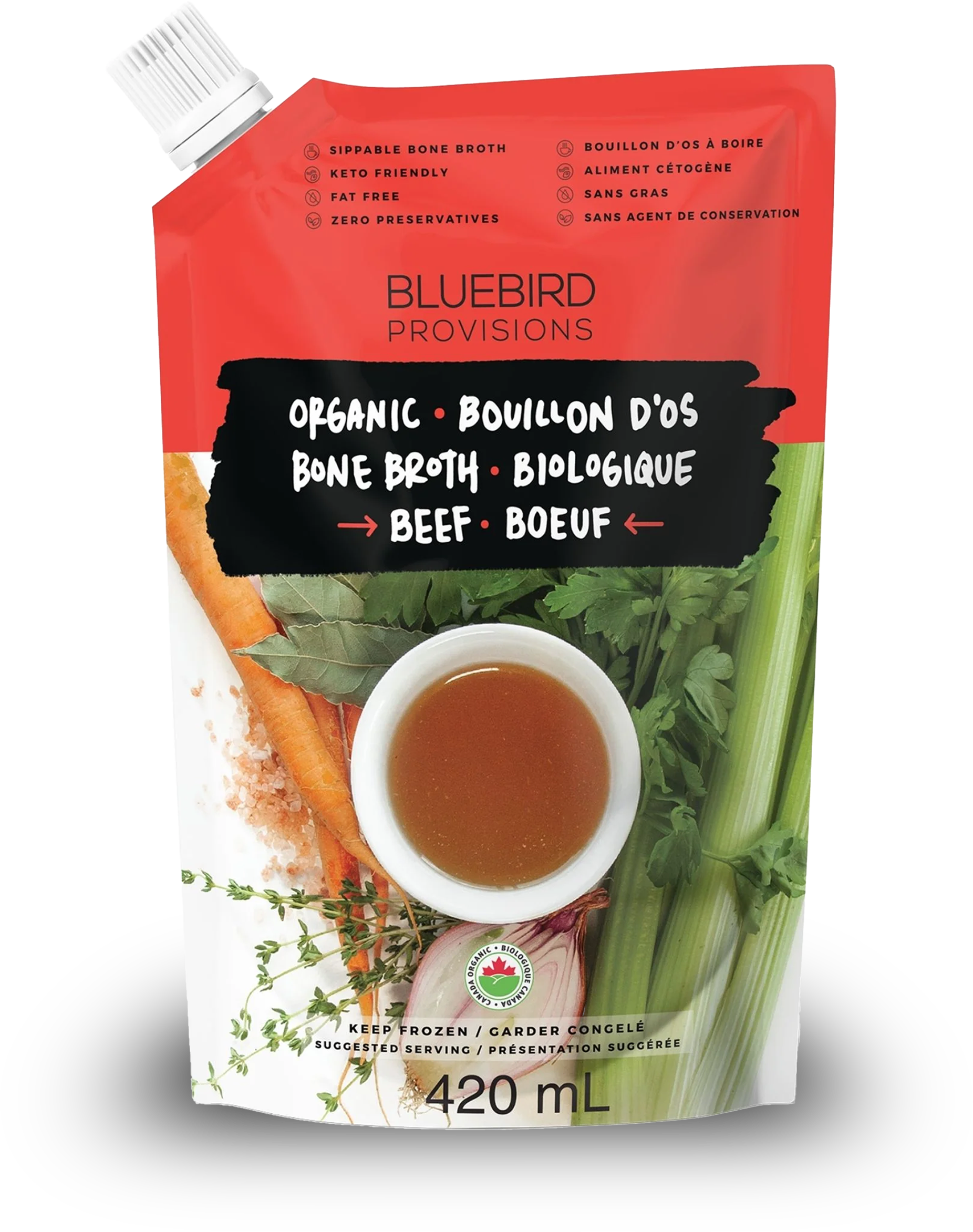




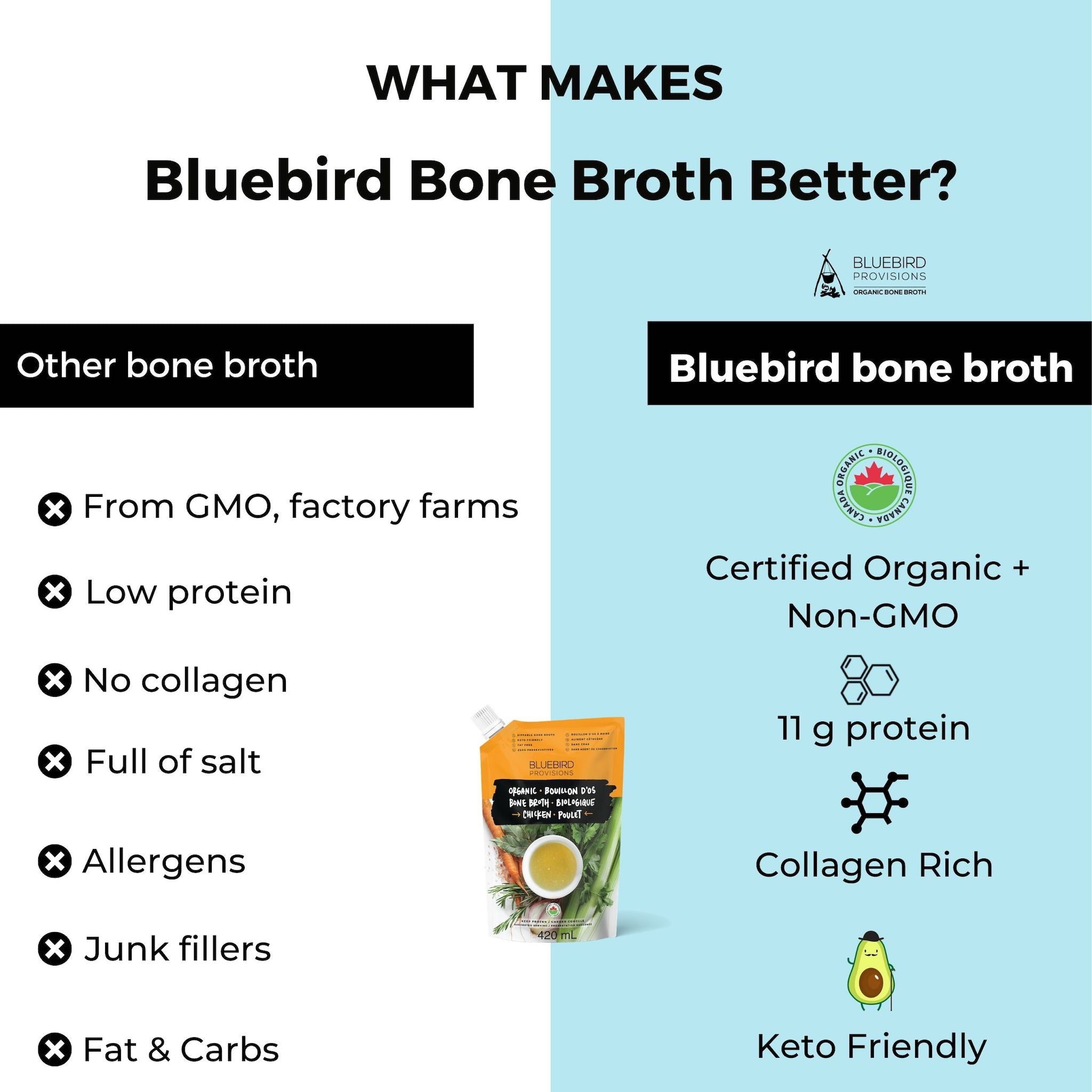
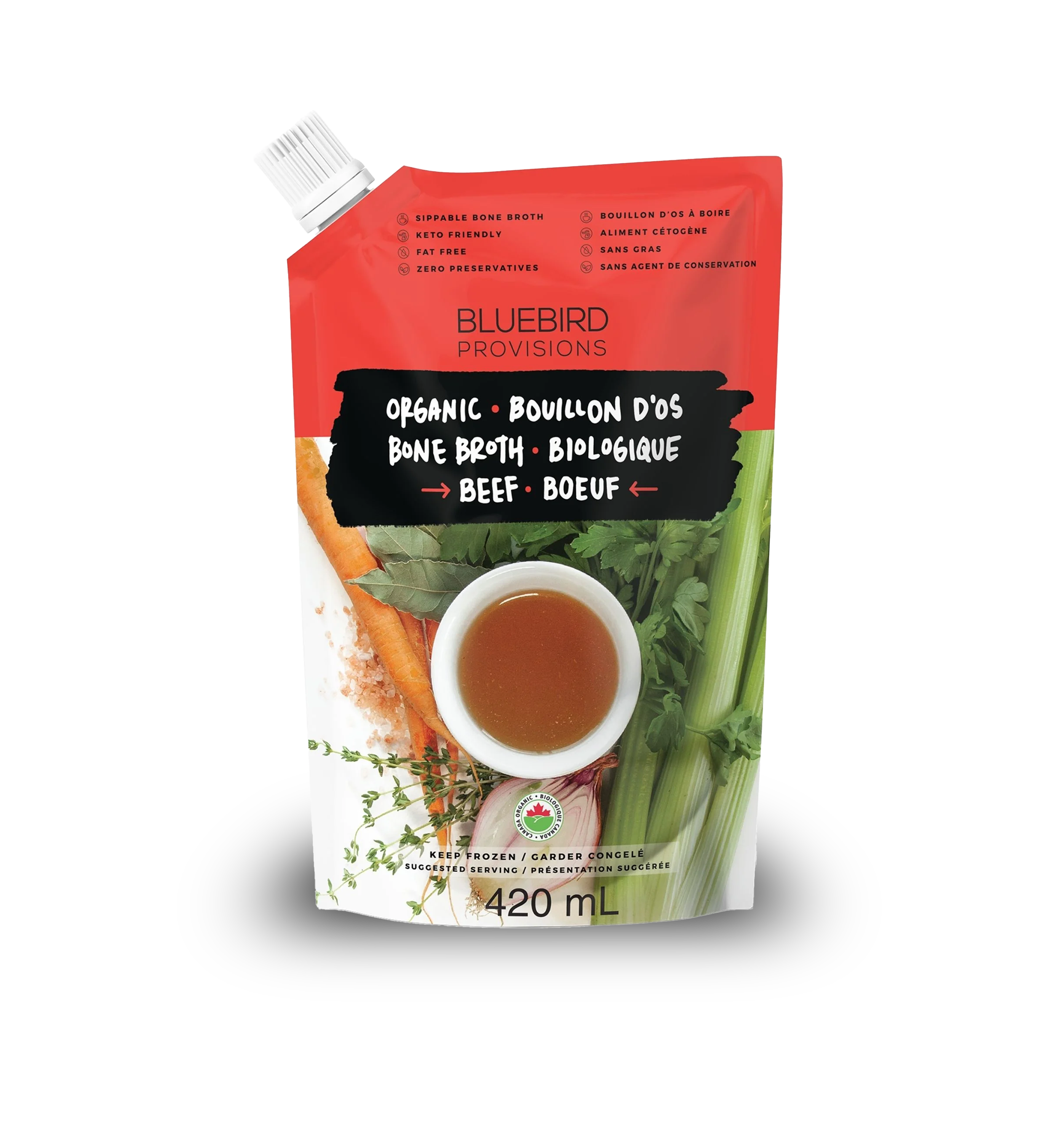
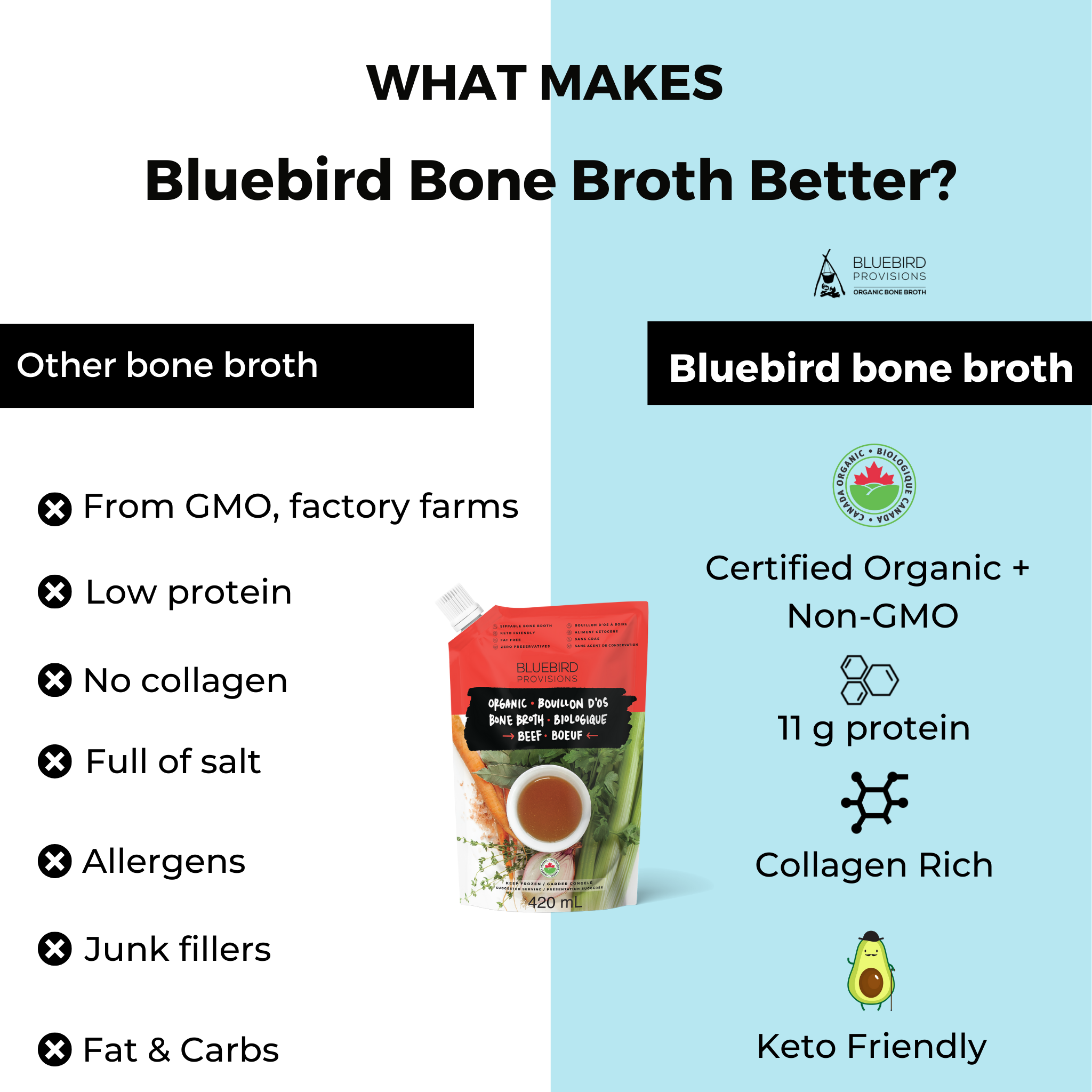
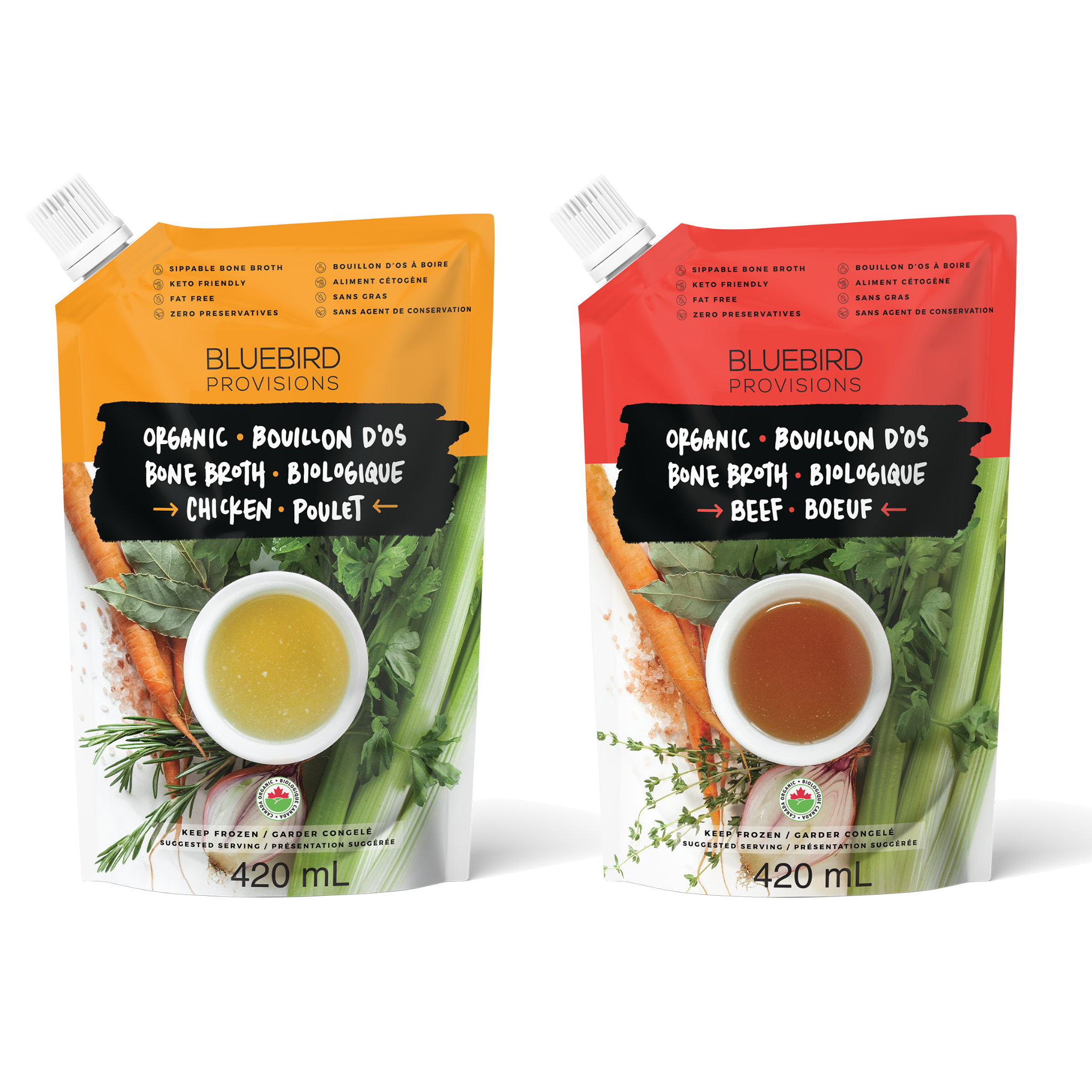
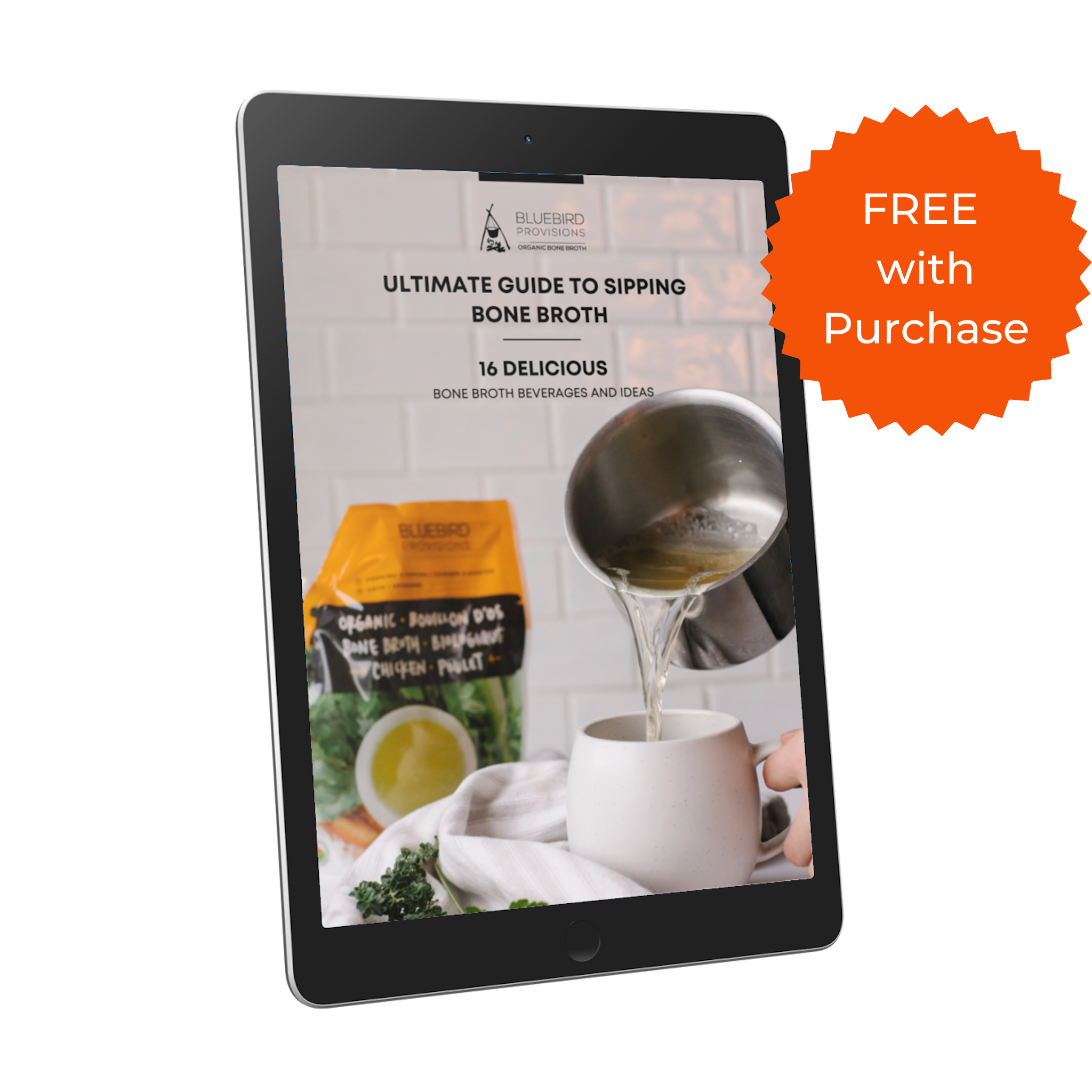
127 comments
I started making bone broth when my 90 yr old mom broke her shoulder. Her doc said it would never heal. 3 months later, with chicken b broth.and nettle tea, he was astonished that it had. I used an older recipe, partially adjusted for flavor. It was so delicious I had to stop myself from drinking up her elixir b4 I could make another batch. She drank 1 c/day. It was a slow process, but well worth it. Yes there were 2 tbsp of cider vinegar or lemon juice, because I remember well my gradeschool experiment with the chicken bone in vinegar. I found chicken backs at a local butcher for 67 cents/ lb, Roasted half for flavor, boiled raw the rest, after pulling off fat from both which I rendered into “schmaltz” and learned how to use that, the rest simmered super slow for 24 hrs with a remote thermometer, pulled off the meat as soon as cooked for other things. Most delicious, versatile way to use a discarded part of an animal. Gelled firm every time. 24 hr simmer, stovetop.. Wouldn’t do it any other way. Veggies for flavor in the last hour. I’ve tought this to a few friends. If you want a clear culinary broth, that takes different methods. This was for nutrition and flavor
David Randall
Hi there,
Thanks for the information. I apologise if this has previously been addressed and I missed it but wondering about skimming when you pressure cook. Can I cook for 3 hours and skim when remove lid?
Thank you Terry.
Terry
Thanks for your comment Jim. I understand that 10 vs 12 represents a 20% increase.
But these numbers are so small, it represents a rounding error in terms of nutritional benefits when it comes to calcium.
I think context is very important here. Perhaps I should have given more in the article.
The recommended daily intake for calcium is 1000 mg.
10 mg serving represents 0.5% of your recommended daily intake.
12 mg serving represents 0.6%
My goal is to help people save time and money in making bone broth themselves and minimizing mistakes while maximizing the nutrition quality of their homemade broth.
Do you think that 0.5% compared to 0.6% for one serving makes sense for budget conscious shoppers to spend more money on adding apple cider vinegar? I would say no.
If you prefer using apple cider vinegar to get an extra 0.1% of your recommended daily intake of calcium. By all means, go for it.
Connor at Bluebird Provisions
12 vs 10 mg calcium is 20% more. I would call that very significant! Use the vinegar!
Jim Hartmann
Can I use the blood from the turkey I bought at WinCo in making my bone broth?
Hilary
Thanks for posting Melissa. After some thought I do believe you are right. I’ve spoken with our QA team and am now comfortable sharing the lab results. They’ll get pasted into this article this week.
I just read that paper again and appreciate the reminder. Ill paste the conclusion here so people can see:
“The calcium and magnesium levels in home-made or commercial broth/soup, according to the literature and current study, are no more than low tenths of a milligram per serving. These levels are generally a few percent of the DRIs, and so their contributions to daily Ca and Mg requirements are considered to be small.”
Connor at Bluebird Provisions
I just think it’s hilarious that these folks know so much but as one person asked them to share their lab results they’re reply is that Canada won’t allow them it’s all a load of bull sh*t. Apple cider is good. It’s good for a lot of things. Whether anything they say is true or not to me is in question. But I’m learning more from the comments. I’m going here to see what this commenter shared https://www.ncbi.nlm.nih.gov/pmc/articles/PMC5533136/
MELISSA ESTES
You’re welcome J!
Connor at Bluebird Provisions
I love how sensible this is. Thanks for posting.
J
Hi Salman,
No you do not need to blanch if you are skimming.
connor
Connor at Bluebird Provisions
Thanks for the info…. So we do not need to blanch if skimming…. Right??
Salman
Hi Sjoerd,
Thanks for your message.
You can find a great recipe for instant pots here: https://bluebirdprovisions.co/blogs/news/instant-pot-bone-broth-recipe
There’s also info in that article about nutrition if you are using pressure cookers.
connor
Connor at Bluebird Provisions
Hey there,
Thanks for this quite unique education! I work at a butchershop (organic for the matter of fact) and we are about to sell homemade broth. Does pressurecook broth affect the quality you think? Since the process is way less time consuming. And if not so, what would be a good time for pressure cooking?
Have a great day!
Friendely greetings,
Sjoerd from the netherlands
Sjoerd
Hi Marilynn
Here is a great recipe you can use linked below. It would usually include thyme, parsley and pepper.
https://bluebirdprovisions.co/blogs/news/bone-broth-recipe
let me know if you have any questions.
connor
Connor at Bluebird Provisions
I really appreciated your article, thank you for educating me! I want to make homemade beef bone broth. Realize you have a product to sell, but my question is, would homemade recipe include carrots onions celery thyme salt peppercorns, anything else? Thank You!!
Marilynn
Hi Nicole,
Sounds like some good bone broth! Having your bone broth white means the fat coagulated into the broth during the summer. Once this happens its; impossible to fix for this particular batch.
There is nothing wrong with white bone broth. It just looks different.
In the future I would advise a few things.
1. never stir or touch your bone broth while it is simmering. Be gentle when you re-add water as to not disturb it too much.
2. Be diligent with your skimming of the foam, fat and impurities during the first 1-2 hours of the simmer.
These two things usually fix any cloudy bone broth. Please keep me updated on how it goes.
connor
Connor at Bluebird Provisions
Milky Gello
I made beef bone broth this weekend and was told to blanch the bones. It was my first time doing that. After that I roasted them high and long like instructed, (no, they never burned).
I brought them to a boil, and then simmered for 48 hours.
There were lots of bones and enough filtered water to cover, and I added more as it simmered down over two days. It was cloudy from the beginning.
At the end I strained it, cooled it and popped the fat off the top.
I wish I could show a picture because it’s pure white and super gelatinous!!
I will still use it in smooties as I’m sure it’s full of nutrition. But how can I prevent this in the future?
BTW, flavour is not the best when it’s on its own, I pack my smoothies with other superfoods.
Thanks in advance for any advice and reading this to the end:)
Nicole
Hi Karen,
That sounds delicious! Save some for me next time :)
Connor
Connor at Bluebird Provisions
Hi Sean,
As long as you are getting a bone broth that gels at fridge temperature, I would not worry about nutrient loss due to the pressure cooker or extreme heat.
We are nit-picking when you get to the level of performance you are what with your bone broth.
I would enjoy it and not worry about getting anymore nutrition out of it.
Hope this helps.
connor
Connor at Bluebird Provisions
I have had wonderful success using my instantpot pressure cooker for making delicious broth. I throw my carcasses and veggies in there with water about half way to 2/3 up and cook for 1 hour and 15 minutes at pressure… then I strain it and take the tiny bones out. Often the bones are so soft I can crush them with two fingers. I will send it through again to get every last bit of goodness out. At least I think that’s what happened… I’ve done it so many times I just go by feel and taste. haha
Karen
I make bone broth for flavor and nutrition is secondary. If I made it the way some suggested I’d be at it for 48 hours of nonsensical simmering so I’d never make it. I make enough and use enough that I’m sure I get the nutritional benefits.
I’m curious as to your thoughts/lab results on the higher temp method. I am fortunate to have unlimited rotisserie and or whole chickens. I use both but my method is fill large pressure cooker with 6 carcasses toss in celery onion and pressure cook 1 hour then strain and toss the solids, chill the liquid stock and remove chicken fat (liquid gold, schmaltz) and I’m left with about 4 quarts of bone broth. I season as I use it and absolutely use the skimmed fat as a soup base, fat for homemade noodles etc. so my question.
Is there a dramatic nutritional loss from the pressure cooker heat? I get plenty of collagen as evidenced from my stock becoming gelatin when chilled. Thank you for a great article!
Sean D
Hi Denice,
Yes we used to do this all the time. The 2nd batch will not be quite as strong or concentrated as the first, but you can cook it a bit longer and hotter to make up for it. Unfortunately we cannot do that anymore due to the food regulations in Canada.
Connor at Bluebird Provisions
Thanks for the great info! Do you guys reuse bones to make another batch of bone broth?
Denice
Thanks for sharing the research Larissa!
Connor at Bluebird Provisions
Hi Shelby
Sounds like you are making some delicious bone broth! Your bone broth still has some nutritional benefit. However, it likely does not have enough protein in it for it to gel.
This is likely because of your bones to water ratio. You may need to double the amount of carcasses you are using in order to get it to gel. Or else you could try adding in some chicken feet or wings to get more gelatin.
Hope this helps and let me know how it goes.
connor
Connor at Bluebird Provisions
Since you didn’t source any of your content…I am just going to leave this here.
https://www.ncbi.nlm.nih.gov/pmc/articles/PMC5533136/
Only misinformed bloggers complain about other misinformation. People with facts are happy to share them.
Larissa A Kempf
Hello, I make chicken bone broth regularly using two full chicken carcasses in a slow cooker. I boil for about 35-40 hours and the broth tastes delicious! I always skim the hard fat off the top after it has cooled. However, while my broth tastes delicious, it never turns to gelatine- it is always a thin runny liquid. So, for the past 3 years that I have been making it, and thinking I was drinking bone broth, have I been doing something wrong? If it never is thick and gelatiney, does that mean it doesn’t have the healthy properties??
Trying my hand now at beef bone broth for the first time so hoping that hardens when cooled…
Thank you!
Shelby
Shelby Anderson
Hi Sean,
From a nutrition standpoint, it does not matter whether you roast the bones or not. From a taste perspective, I think roasting the bones does make it taste better with a greater depth or flavor.
It is up to you. For a recipe you can read this article: https://bluebirdprovisions.co/blogs/news/bone-broth-recipe
connor
Connor at Bluebird Provisions
Hi Michelle
Thanks for reading and trying out bone broth! I think what you are doing is fine. You can make chicken bone broth with a 5-6 hour boil. It really comes down to how concentrated your final bone broth is after this boil. Does it gel in the fridge? If not, then you could consider boiling a bit longer next time you make it.
Hope this helps and let me know if you have any other questions.
connor
Connor at Bluebird Provisions
Hi winston,
Unfortunately we cannot publish our lab results at this point for ur bone broth.The Canada Food Inspection Agency requires that we keep it confidential.
Connor at Bluebird Provisions
I am new to Bone Broth making but am unclear about prep’ ie should I roast the bones before slow cooking or put the bones straight in water and cook? Or does it not really matter?
Sean
Hi, Thank you for the helpful info!
I make broth regularly, mostly with chicken bones and heavy on the veggies and mushrooms. I’ve always wondered if I should have been adding the apple cider vinegar or blanching/draining and continuing for purer broth but have never bothered so I appreciate your reassurance.
Also I’ve been using a heavy Le Creuset pot with a stainless strainer insert which unfortunately fills up quickly when adding a whole carcass and veggies, if I cover with water I have to carefully monitor it’s boil or it will overflow until it’s boiled down a bit. I continually add water to keep a decent boil and the ability to skim. I continue doing that until everything seems well cooked down and the broth tastes yummy….
My question to you is if cooking broth like this on a heavy boil but adding water only takes 5 or 6 hours, is that enough time to exract the collagen and nutrients or should I plan better and make sure I cook the broth for longer?
Thank you for your time.
Michelle
Curious if you would mind posting the results of the many lab tests you have done.
winston ford
Hi Jeannette,
You can absolutely use raw chickens to make bone broth. It will make delicious broth!
let me know how it goes.
connor
Connor at Bluebird Provisions
Can you buy a couple of raw whole chickens and simmer that for a broth?
Jeannette Robinson
Hi Jay,
I don’t think it will help because the chicken bones are already so small. If you do try to break the bones, be careful of shards or anything when you strain it.
Connor
Connor at Bluebird Provisions
If using all leg bones with chicken, would cracking the bones before cooking add any benefit?
Jay
Hi Diane,
Yes pork feet and bones makes for a delicious bone broth! You can follow our beef bone broth recipe to make a great pork bone broth.
You don’t see as many recipes because pork is simply not as popular as chicken and beef. And also, I suspect that the pork industry has more baggage historically with the type of people who are inclined to make bone broth in the west. I think this is a major reason why it is not as popular.
Connor at Bluebird Provisions
Hi Dave,
Yes I would do exactly what you mentioned. Just remove the tallow at the end once it hardens / cools. Much easier to remove and dispose that way.
On that note: the compost partner we have does accept tallow / fat in the organic compost material. Soo 100% of it gets composted. Perhaps some municipalities don’t, but I am not sure.
It is also a joy to cook with. I cook with tallow and chicken schmaltz all the time.
Connor at Bluebird Provisions
Is using pork such as pigs feet an okay thing to do? Why do I not see any bone broth recipes using pork bones?
Diane
Hi Conor, so I think I’m right in picking up that: if one is not concerned about cloudiness, it’s ok to simply not bother skimming and instead, wait until the end and, after cooling, remove the layer of tallow from the top, job done? On that subject, how do you dispose of your fats (whether skimmed or removed at the end)? I am loathe to put down the sink, and have heard that they aren’t appropriate for compost…so do you dispose in the general waste for landfill? (I have no inclination to turn it into moisturising cream or candles or whatever!)
Dave
Hi Dave,
That is a great question, and one I have seen come up in debates. From my perspective, there is no proof or validity to the fat cap on bone broth being rancid fat. I will say I’m not a fatty acid expert. So if you are concerned, you can always remove the fat to isolate the collagen protein.
Hope this helps!
connor
Connor at Bluebird Provisions
Hi M,
For skimming, the purpose is to remove the fat so that it minimizes the chance of the fat cooking or incorporating into the your broth during your simmer. If this happens, you end up with ‘cloudy’ bone broth. Cloudy bone broth will typically have more fat than clear, but otherwise, there are no issues with it.
I like to skim and remove the fat because our guests prefer a clear, high protein bone broth.
Connor at Bluebird Provisions
At last, a site that talks about bone broth from a scientific perspective, I like it! Here’s a question that I suspect you will have a great answer to: what’s the lowdown on rancidity of fats in the context of a bone broth? Some say to take your first batch of broth at three hours to capture the fats prior to them becoming rancid, followed by a second boil for the collagen etc. That is, one product full of good fats and a second of pure collagen. Is there any scientific validity to that?
Dave
What’s the purpose of skimming the top? What impurities would rise to the top? I’ve never skimmed my broth before.
M
Hi Djane,
An instant pot is not necessarily better than stove top. It is simply a faster way to make bone broth compared to on a stove.
Connor
Connor at Bluebird Provisions
Hi Cheryl,
Thanks for your comment. You sound like you are doing things the right way with bone broth!
Regarding extreme heats. I don’t think you there is a risk of denaturing protein or collagen at most cooking heats (ex: stove top of pressure cooker). I would not worry about that. We’ve never seen any protein or collagen lose nutrients due to extreme heat.
I don’t think there is any scientific validity to the claims on the interest about heat.
For skimming. I think that would be a great idea. But as you said, it’s a bit of a nuisance. You are best to keep things simple and don’t bother, especially if you don’t mind cloudy bone broth.
As for adding egg shells, I haven’t heard of anyone trying this. You should give it a go and please report back. I would be very curious to hear what it adds to the broth. In theory it should add some more collagen, which is great!
All the best
connor
Connor at Bluebird Provisions
What about making chicken bone broth in an instant pot better or worse then stovetop to get collagen
Djane
Hi, Connor! Thank you so much for your really informative article, and I am definitely going to purchase some of your broth to sample! I’m sure it’s high quality and delicious, and I am looking forward to it!
I found you, btw, when searching for info on the dangers to collagen of high heat. A commenter here gave a helpful reminder on the issue of “temperature” w regard to slow or fast boiling (temp remains the same) but also pointed out that heat only increases when pressure increases.
And this brings me straight to my initial question: Is it true that a higher heat, such as one might get on the max or even low setting of a pressure cooker, risks “breaking down” (damaging, destroying?) the proteins in the collagen? I had heard this concern on a YouTube video regarding making bone broth, where it was advised to use only the low setting of an Instant Pot pressure cooker and cook for only 2 hours bcz of the risk to the quality of the collagen. Is there any validity to this?
(I also saw a comment here which claimed to get excellent broth from 5 hrs on a max setting of an IP, so perhaps there isn’t any reason for concern?)
Lastly, for those wondering how to skim when using a pressure cooker, I haven’t tried it yet but was thinking one could just start the broth on the stovetop, skim after 10-30 min at a boil, and then simply transfer the bones and broth to the cooker. This would mean a bit of “stirring,” of course, so maybe not ideal, but at least preferable to not skimming at all for those who care.
(Personally, I skim somewhat but don’t really care about cloudiness, since i assume some of it is healthy marrow anyway and i mostly use my broth for meaty keto soups. I make my broth using water in which I have first cooked 2 or 3 chicken legs n wings and 1 turkey neck, wing or leg. I then remove the meat for use later in soups, return the bones to the water, along w a beef marrow bone, some veggies n herbs, and simmer for 16-24 hrs, which yields a very gelatinous broth!)
Just thought of one last question: Do you think one could also boil egg shells with the bones, in order to take advantage of the collagen-rich shell lining, which is otherwise so hard to remove? And if so, I wonder if adding some acid wouldn’t help extract calcium from the shells, even if not from the bones! (I had been adding ACV until I read your article, but will now just add it before consuming the broth, to enjoy both the flavor (I do) AND it’s probiotic benefits, which heat destroys.
Anyway, thanks again, and thanks in advance for your reply.
Cheryl H
Hi Viv,
There is no problem with cloudy broth. It tastes great and has all the nutritional benefits of bone broth.
As for blanching your bones, I’m not sure I agree that it removes impurities and results in cleaner broth. You can remove these impurities via a proper skim process. If you have the time then you can blanch, if not, don’t worry about it.
Hope this helps and let me know if you have any other questions.
Connor
Connor at Bluebird Provisions
Leave a comment
This site is protected by hCaptcha and the hCaptcha Privacy Policy and Terms of Service apply.